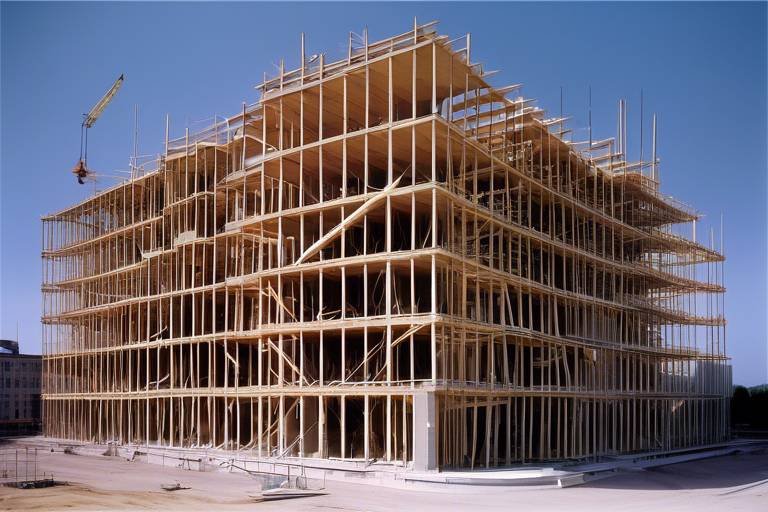The Physics of Construction - How Buildings Stand
Have you ever stopped to think about what keeps our skyscrapers standing tall against the forces of nature? It's not just the artistry of the architects or the skill of the builders; it's the fascinating world of physics that plays a crucial role in the stability and longevity of buildings. In this article, we’ll explore the fundamental principles of physics that ensure our structures remain strong and resilient, even against the most challenging conditions.
Every building is subject to a variety of forces that can significantly impact its structural integrity. The most obvious of these is gravity, which pulls everything down toward the Earth. When designing a building, engineers must calculate how much weight each part of the structure will bear and ensure that these loads are properly distributed. But gravity isn't the only force at play. Wind can exert tremendous pressure on buildings, especially in tall structures, which can sway and bend. Additionally, in areas prone to earthquakes, seismic activity introduces lateral forces that can cause buildings to shift and even collapse if not properly accounted for. Understanding how these forces interact is essential for creating structures that stand the test of time.
The choice of materials in construction is another vital aspect influenced by physics. Different materials have unique physical properties that determine their strength, durability, and suitability for various applications. For instance, concrete is renowned for its compressive strength, making it ideal for foundations and structural supports, while steel is favored for its tensile strength, allowing for the creation of expansive spaces and innovative designs. By understanding the strengths and weaknesses of these materials, architects and engineers can make informed decisions that enhance the overall stability of a building.
When it comes to construction, concrete and steel are the heavyweights of the industry. Concrete is a composite material made from cement, water, and aggregates, and it hardens over time to become incredibly strong. It can withstand heavy loads and is resistant to fire and weathering, making it a staple in modern construction. On the other hand, steel is a metal alloy that offers remarkable strength-to-weight ratios, allowing for tall and slender structures that would be impossible with concrete alone. The combination of these materials often leads to the creation of buildings that are not only functional but also aesthetically pleasing.
Concrete has several advantages that make it a preferred choice in construction. Its compressive strength allows it to bear heavy loads without crumbling, making it perfect for foundations and structural walls. Additionally, concrete is highly versatile; it can be molded into various shapes and sizes, accommodating a wide range of architectural designs. Furthermore, its resistance to environmental factors such as moisture and fire enhances its durability, ensuring that buildings remain safe and sound for years to come.
Steel, on the other hand, brings its own set of benefits to the table. Its tensile strength allows for longer spans and open spaces within buildings, allowing for innovative designs that are both functional and beautiful. Steel is also highly flexible, meaning it can bend without breaking, which is crucial in areas prone to high winds or seismic activity. This flexibility, combined with its strength, makes steel an ideal choice for modern architectural marvels.
As technology advances, so do construction techniques. Innovations such as modular construction, where buildings are prefabricated in sections, and 3D printing, which allows for rapid and precise construction, are revolutionizing the industry. These methods not only improve efficiency but also enhance the safety and stability of buildings by leveraging physics in new and exciting ways. Sustainable practices are also gaining traction, focusing on materials and methods that minimize environmental impact while maximizing structural integrity.
When it comes to ensuring that buildings can withstand various stresses, design principles play a crucial role. Key concepts such as load distribution, symmetry, and redundancy are essential for architects and engineers. For instance, load-bearing structures are designed to support weight efficiently, distributing loads evenly throughout the building. This careful consideration of forces and materials ensures that buildings remain stable and safe, even under extreme conditions.
Understanding the concept of load-bearing structures is fundamental for construction. These designs are crafted to support not just their own weight but also the weight of everything within and upon them. By utilizing materials with appropriate strengths and distributing loads effectively, engineers can create buildings that maintain stability under different conditions, ensuring safety for occupants and longevity for the structure.
Finally, there's the ongoing balance between architectural aesthetics and the physical requirements of building design. While creativity and innovation are vital for captivating designs, they must also align with structural integrity. Architects often find themselves navigating this delicate dance, ensuring that their visions do not compromise the safety and stability of the building.
- What are the main forces acting on buildings? Buildings are primarily affected by gravity, wind, and seismic activity.
- Why is concrete a popular building material? Concrete is strong, versatile, and resistant to fire and environmental factors.
- How does steel contribute to modern architecture? Steel offers high tensile strength and flexibility, allowing for innovative designs.
- What is modular construction? Modular construction involves prefabricating sections of buildings off-site for quicker assembly.

Understanding Forces in Construction
When we think about buildings, we often admire their beauty and design, but have you ever wondered what keeps them standing tall against the forces of nature? Understanding the various forces at play in construction is crucial for ensuring that our structures are not only aesthetically pleasing but also safe and durable. The primary forces that act on buildings include gravity, wind, and seismic activity. Each of these forces influences how a building is designed and constructed, and recognizing their impact is fundamental to the field of architecture and engineering.
First and foremost, let's talk about gravity. This invisible force pulls everything towards the Earth, and it's the reason why buildings must be designed to support their own weight. Imagine a stack of books; if you add too many on top, the bottom ones will buckle under the pressure. Similarly, in construction, engineers must calculate the load that each part of a building will bear to prevent structural failure. This is where the concept of load distribution comes into play, ensuring that weight is evenly spread across the structure.
Next up is wind, a force that can be both gentle and fierce. High winds can exert significant pressure on buildings, especially tall structures. Architects often use aerodynamic shapes to help buildings deflect wind rather than resist it, much like a bird gliding through the air. For instance, skyscrapers are designed with rounded edges and tapered tops to minimize wind resistance. Additionally, engineers must consider wind load calculations to ensure that a building can withstand gusts without swaying excessively or, in extreme cases, collapsing.
Seismic activity, or earthquakes, introduces another layer of complexity. Buildings in earthquake-prone areas are designed with flexibility in mind. Think of a tree swaying in the wind; its ability to bend without breaking is what keeps it standing tall. Engineers often incorporate base isolation systems and dampers that allow buildings to move independently from the ground motion, reducing the risk of structural damage. This proactive approach to design is essential for protecting lives and property in regions where seismic activity is a concern.
To summarize, the forces of gravity, wind, and seismic activity are critical considerations in the construction of buildings. Each force requires a unique approach to design and engineering, ensuring that structures can withstand the challenges posed by nature. Understanding these forces not only enhances the safety and stability of buildings but also elevates the overall quality of life for those who inhabit them.
- What are the main forces that affect buildings? The main forces include gravity, wind, and seismic activity.
- How do engineers calculate load distribution? Engineers use various formulas and simulations to ensure that weight is evenly distributed across a structure.
- What is base isolation? Base isolation is a technique used to allow buildings to move independently from ground motion during an earthquake.
- Why is wind resistance important in skyscraper design? Wind resistance is crucial because high winds can exert significant pressure on tall buildings, potentially leading to structural failure.

The Role of Materials
When it comes to construction, the choice of materials is paramount. Think of it like building a cake; the ingredients you select will determine not only the flavor but also the structure and stability of the final product. In construction, materials such as concrete, steel, wood, and glass play critical roles in ensuring that a building stands strong against various forces. Each material comes with its own set of physical properties, strengths, and weaknesses, influencing how architects and engineers design structures to withstand the test of time and nature.
One of the most important aspects to consider is how different materials respond to various forces. For instance, the weight of a building exerts a downward force due to gravity, while wind and seismic activity can introduce lateral forces. The materials chosen must be able to handle these stresses without compromising the integrity of the structure. To better understand this, let's take a look at some commonly used materials and their characteristics:
| Material | Strength | Durability | Common Uses |
|---|---|---|---|
| Concrete | High compressive strength | Excellent resistance to environmental factors | Foundations, walls, pavements |
| Steel | High tensile strength | Corrosion-resistant with proper treatment | Frameworks, beams, reinforcements |
| Wood | Good tensile strength | Vulnerable to moisture and pests | Framing, flooring, decorative elements |
| Glass | Varying strength depending on type | Can be fragile but treated for strength | Windows, facades, decorative features |
As illustrated in the table above, each material has its own unique properties that can significantly affect the overall stability of a building. For example, concrete is renowned for its compressive strength, making it ideal for supporting heavy loads. On the other hand, steel is celebrated for its tensile strength and flexibility, allowing for more innovative architectural designs that can withstand extreme conditions.
Moreover, the choice of materials is not just about strength; it's also about versatility and aesthetic appeal. Modern construction often involves a mix of materials to achieve both functionality and beauty. For instance, the use of glass in buildings not only allows for natural light to flood the interiors but also adds an element of elegance. Architects and engineers must strike a balance between these various factors, ensuring that the materials selected not only meet the physical demands but also align with the overall vision of the project.
In summary, the role of materials in construction cannot be overstated. They are the backbone of any structure, influencing everything from the design to the durability of a building. As technology advances, new materials and techniques are emerging, allowing for even greater innovation in construction. This evolution opens up exciting possibilities for the future of architecture, making it an exhilarating field to watch.
- What is the most commonly used material in construction? Concrete is often the most widely used material due to its strength and durability.
- How do materials affect building design? The properties of materials dictate how buildings can be designed to withstand loads and environmental factors.
- Are there sustainable materials for construction? Yes, materials such as bamboo and recycled steel are becoming popular for sustainable construction practices.

Concrete and Steel
When it comes to the world of construction, concrete and steel are the dynamic duo that forms the backbone of most modern buildings. Imagine a sturdy fortress that can withstand the test of time, weather, and even the occasional earthquake—this is the magic that these materials bring to the table. Both materials have unique properties that not only contribute to the structural integrity of buildings but also allow architects to push the boundaries of design and creativity.
Concrete, a mixture of cement, water, and aggregates, is renowned for its compressive strength. This means it can withstand heavy loads without crumbling, making it an ideal choice for foundations and walls. Its versatility is unmatched; it can be poured into any shape, allowing for innovative architectural designs. Furthermore, concrete is highly resistant to environmental factors such as fire, moisture, and even pests, which means buildings can last for decades without significant maintenance.
On the other hand, steel is the superhero of tensile strength. It can stretch and bend without breaking, which is crucial for structures that need to endure dynamic forces like wind or seismic activity. Steel's flexibility allows for taller buildings with open spaces, as it can support large spans without requiring numerous columns. This not only enhances the aesthetic appeal but also maximizes usable space within a building. The combination of concrete and steel in construction is often referred to as reinforced concrete, where steel bars or mesh are embedded within concrete to enhance its tensile strength. This synergy allows for the creation of robust structures that are both functional and visually striking.
To better understand the differences and advantages of these materials, let's take a look at the following table:
| Property | Concrete | Steel |
|---|---|---|
| Compressive Strength | High | Low |
| Tensile Strength | Low | High |
| Flexibility | Rigid | Flexible |
| Resistance to Fire | High | Moderate |
| Durability | Very Durable | Durable but can corrode |
In summary, the combination of concrete and steel not only enhances the structural performance of buildings but also opens the door to innovative architectural designs. As we continue to explore new technologies and materials in construction, the collaboration between these two giants will undoubtedly play a crucial role in shaping the skyline of our cities.
- What is reinforced concrete?
Reinforced concrete is a composite material that combines concrete and steel reinforcement bars (rebar) to improve its tensile strength and overall durability. - Why is steel preferred for tall buildings?
Steel is preferred for tall buildings due to its high tensile strength and flexibility, allowing for larger spans and open spaces without compromising stability. - How does concrete resist environmental factors?
Concrete is inherently resistant to fire, moisture, and pests, making it a durable choice for construction in various environments.

Advantages of Concrete
Concrete is often hailed as one of the most versatile and durable construction materials available, and for good reason. One of its most significant advantages is its compressive strength. This means that concrete can withstand heavy loads without cracking or breaking, making it ideal for foundations, walls, and other structural components. In fact, when properly mixed and cured, concrete can achieve compressive strengths exceeding 30 megapascals (MPa), which is roughly equivalent to the strength of steel in some applications!
Another remarkable feature of concrete is its versatility. It can be molded into various shapes and sizes, allowing architects and engineers to unleash their creativity while ensuring structural integrity. Whether it’s a sleek modern skyscraper or a rustic bridge, concrete can adapt to the design requirements without compromising safety. Plus, with the incorporation of additives, concrete can be engineered to have specific properties, such as improved workability or accelerated curing times, making it suitable for a wide range of applications.
Furthermore, concrete exhibits excellent resistance to environmental factors. It is inherently fire-resistant, which means that structures made from concrete can withstand extreme temperatures without losing their structural integrity. This feature is particularly vital in urban areas where fire hazards are a concern. Additionally, concrete is resistant to moisture and pests, which helps prevent issues like rot and decay that can plague other materials, like wood.
Moreover, the longevity of concrete structures is another critical advantage. When properly maintained, concrete can last for decades, if not centuries. This durability translates to lower maintenance costs over time, making it a cost-effective choice for builders and developers. To illustrate this point, consider the Roman Pantheon, which has stood for nearly 2,000 years, showcasing the remarkable resilience of concrete.
To sum it up, here are some key advantages of using concrete in construction:
- High compressive strength for load-bearing applications
- Versatility in design and form
- Environmental resistance to fire, moisture, and pests
- Longevity leading to lower maintenance costs
In conclusion, concrete is not just a building material; it’s a cornerstone of modern construction that combines strength, flexibility, and durability. Its advantages make it a preferred choice for architects and engineers who strive to create structures that are not only aesthetically pleasing but also capable of standing the test of time.
Q: What makes concrete so strong?
A: Concrete's strength comes from the chemical reaction between cement and water, which forms a strong bond as it cures. The aggregates used in the mix also contribute to its compressive strength.
Q: How long does concrete take to cure?
A: Concrete typically takes about 28 days to reach its full strength, but it begins to harden within hours of pouring. Factors like temperature and humidity can affect curing time.
Q: Can concrete be recycled?
A: Yes, concrete can be crushed and reused as aggregate in new concrete mixes or as a base material for roads and other construction projects, making it an environmentally friendly option.

Benefits of Steel
When it comes to construction, steel is often hailed as a superhero among materials. Why? Well, its tensile strength is one of the highest of any construction material, which means it can withstand a lot of pulling and stretching without breaking. Imagine trying to stretch a rubber band; it can only take so much before it snaps. Steel, on the other hand, can be stretched and bent far beyond what many materials can handle, making it a fantastic choice for structures that need to be both strong and flexible.
Another remarkable feature of steel is its versatility. It can be molded into various shapes and sizes, allowing architects and engineers to push the boundaries of design. Whether it's a sleek skyscraper or a complex bridge, steel can adapt to the vision of the designer while maintaining the necessary structural integrity. This adaptability is akin to a skilled artist who can switch between styles, creating masterpieces that are both functional and beautiful.
Moreover, steel's resistance to extreme conditions cannot be overlooked. Unlike wood, which can rot or warp, or concrete, which can crack under pressure, steel remains durable and reliable. It can withstand harsh weather conditions, including high winds, heavy snow, and even seismic activity. This resilience makes it an ideal choice for buildings in areas prone to natural disasters. In fact, many modern skyscrapers are designed with steel frames that allow them to sway slightly during earthquakes, minimizing the risk of collapse.
Additionally, steel is eco-friendly. It is 100% recyclable, which means that old steel structures can be melted down and repurposed into new ones. This not only reduces waste but also lowers the demand for new raw materials, making steel a sustainable option for future construction projects. In a world increasingly focused on environmental impact, choosing steel can be a step towards greener building practices.
In terms of cost-effectiveness, while the initial investment in steel may be higher than other materials, its longevity and low maintenance requirements often lead to lower overall costs. Buildings constructed with steel can last for decades, if not longer, with minimal upkeep. This is much like investing in a quality pair of shoes; they may cost more upfront, but they save you money in the long run because you won’t need to replace them every few months.
To summarize, here are the key benefits of using steel in construction:
- Tensile Strength: Can withstand significant stress without breaking.
- Versatility: Easily molded into various shapes for innovative designs.
- Durability: Resistant to extreme weather and seismic activity.
- Eco-Friendliness: 100% recyclable and sustainable.
- Cost-Effectiveness: Long-lasting with low maintenance needs.
In conclusion, the benefits of steel extend beyond its physical properties. It embodies a perfect blend of strength, flexibility, and sustainability, making it an indispensable material in modern construction. Whether you are building a towering skyscraper or a simple residential home, steel is a choice that promises durability and elegance, ensuring that structures not only stand tall but also stand the test of time.

Innovative Construction Techniques
In today’s fast-paced world, the construction industry is undergoing a remarkable transformation, driven by innovation and the need for efficiency. As we embrace the future, we are witnessing the emergence of cutting-edge techniques that not only enhance the stability of buildings but also promote sustainability and reduce costs. One of the most exciting developments is modular construction, where structures are built off-site in controlled environments and then assembled on location. This method minimizes waste and construction time, while ensuring high-quality standards. Imagine building a complex like a giant puzzle, where each piece is crafted with precision before it comes together to form a sturdy whole.
Another game-changer in the construction arena is 3D printing. This technology allows for the creation of intricate designs and components that were once deemed impossible to manufacture. With the ability to layer materials precisely, 3D printing can produce everything from simple walls to complex architectural features, all while using less material than traditional methods. Think of it as a high-tech cake maker, layering ingredients to create a masterpiece that is both beautiful and functional.
Moreover, the integration of sustainable practices into construction techniques is becoming increasingly vital. More builders are opting for eco-friendly materials and energy-efficient designs that not only reduce the environmental footprint but also enhance the longevity of structures. For instance, using recycled materials or incorporating green roofs can significantly improve a building’s energy efficiency and aesthetic appeal. It’s like dressing your home in a sustainable outfit that looks great and feels even better for the planet.
To further illustrate these innovative techniques, let’s take a look at a comparison of traditional vs. modern construction methods:
| Aspect | Traditional Construction | Innovative Techniques |
|---|---|---|
| Time Efficiency | Longer project timelines due to on-site construction | Reduced timelines through off-site modular building |
| Material Waste | Higher waste levels due to on-site adjustments | Lower waste through precise manufacturing methods |
| Design Flexibility | Limited by conventional building methods | Highly flexible with 3D printing and modular designs |
| Sustainability | Less focus on eco-friendly practices | Emphasis on sustainable materials and designs |
As we continue to explore these innovative techniques, it’s clear that the future of construction is not just about building structures but about creating smart, sustainable environments that can withstand the test of time. The marriage of technology and traditional construction practices is paving the way for a new era where buildings are not only functional but also harmoniously integrated into their surroundings. As we embrace these advancements, we must also consider the balance between creativity and structural integrity, ensuring that our architectural dreams are grounded in the principles of physics.
- What is modular construction? Modular construction involves prefabricating building sections in a factory setting, which are then transported and assembled on-site, significantly reducing construction time.
- How does 3D printing benefit construction? 3D printing allows for the creation of complex designs with less material waste, enabling faster and more efficient building processes.
- What are some sustainable construction practices? Sustainable practices include using recycled materials, energy-efficient designs, and incorporating green technologies like solar panels and green roofs.
- Why is understanding physics important in construction? Understanding physics helps architects and engineers design buildings that can withstand various forces, ensuring safety and longevity.

Design Principles for Stability
When it comes to constructing buildings that can withstand the test of time, play a pivotal role. Architects and engineers must consider various factors that contribute to the overall stability of a structure. Imagine building a house of cards; if you don’t balance the cards properly, the entire structure collapses. In a similar way, the principles of design ensure that a building can bear loads, resist forces, and maintain its integrity even under adverse conditions.
One of the fundamental principles is load distribution. This concept revolves around how weight is transferred throughout a structure. Just as a bridge must evenly distribute the weight of vehicles crossing it, buildings must distribute loads from the roof down to the foundation. If one part of the structure bears too much weight, it can lead to catastrophic failure. Engineers often use advanced calculations and simulations to ensure that loads are adequately managed, allowing for a safe and sound design.
Another crucial principle is symmetry. Symmetrical designs tend to be more stable because they distribute forces evenly. Think of a seesaw; when both sides are equal, it balances perfectly. However, if one side is heavier, it tips over. This analogy applies to buildings as well; when a structure is symmetrical, it can better resist natural forces like wind and earthquakes. Architects often strive for symmetry not just for aesthetics but also for structural soundness.
Redundancy is yet another key design principle. This concept involves creating multiple pathways for loads to travel through a structure. In essence, it’s like having backup plans in case something goes wrong. If one part of a building fails, redundancy ensures that other parts can take on the load, preventing a total collapse. For instance, in modern skyscrapers, engineers incorporate multiple support systems to handle unexpected stresses, ensuring that the building remains safe even if one element fails.
When discussing stability, we cannot overlook the importance of foundational design. A solid foundation is the bedrock—quite literally—of any structure. Foundations must be designed to handle the weight of the building and the forces acting upon it, such as soil movement and water pressure. Engineers often conduct soil tests to determine the best foundation type, whether it be shallow, deep, or a combination of both, ensuring that the building stands firm against the elements.
In conclusion, these design principles—load distribution, symmetry, redundancy, and foundational integrity—are essential for creating stable buildings. They work in harmony, much like a well-orchestrated symphony, to ensure that structures not only look beautiful but also stand strong against the forces of nature. As we continue to innovate in construction, understanding these principles will remain vital for architects and engineers alike.
- What is load distribution in construction?
Load distribution refers to how weight is spread throughout a structure to ensure stability and prevent collapse. - Why is symmetry important in building design?
Symmetry helps distribute forces evenly, making structures more stable and resilient against external pressures. - What does redundancy mean in structural engineering?
Redundancy involves having multiple support systems in place, so if one fails, others can take on the load, enhancing safety. - How do foundations contribute to building stability?
A solid foundation supports the entire structure, ensuring it can withstand various forces and environmental conditions.

Load-Bearing Structures
When we think about the **architecture** of a building, we often envision its stunning design and aesthetic appeal. However, beneath that beautiful façade lies a complex system of that play a crucial role in ensuring the building's stability and safety. These structures are essentially the backbone of any construction, designed to support the weight of the building and resist various forces acting upon it, such as gravity, wind, and even seismic activity.
Load-bearing structures can be categorized into two main types: walls and frames. In traditional designs, load-bearing walls are constructed using materials like brick, stone, or concrete. These walls not only provide privacy and shelter but also bear the weight of the floors and roof above. Imagine a stack of books; if you remove a book from the bottom, the entire stack may collapse. Similarly, if a load-bearing wall is compromised, the entire structure can be at risk.
On the other hand, frame structures utilize beams and columns to distribute loads more efficiently. This method allows for larger open spaces within buildings, as walls are not required to bear the weight of the roof. Think of a frame as the skeleton of a building, where each bone (or column) supports the body (or roof) while allowing for flexibility in design. The use of steel and reinforced concrete in these frames provides exceptional strength and resilience, making them ideal for modern skyscrapers and commercial buildings.
One of the fascinating aspects of load-bearing structures is their ability to distribute weight evenly throughout the building. This distribution is crucial because it prevents localized stress that could lead to structural failure. For instance, in a well-designed load-bearing system, if one part of the structure experiences excessive weight—like during a heavy snowfall—the load is transferred to other parts, ensuring that no single component bears too much strain. This principle of load distribution is what keeps buildings standing tall and proud, even in adverse conditions.
Moreover, the concept of redundancy in load-bearing structures cannot be overlooked. Redundancy refers to the inclusion of extra elements in the design that can take over if one part fails. This is akin to having a backup plan; if one route is blocked, you have alternatives to reach your destination. In construction, this means that if a beam were to fail, other beams and columns are in place to support the load, thereby preventing catastrophic failure.
In conclusion, understanding load-bearing structures is essential for anyone interested in construction and architecture. These systems not only support the physical weight of buildings but also embody the principles of physics that govern their stability. As we continue to push the boundaries of architectural design, the importance of robust load-bearing systems will remain paramount in ensuring that our creations can withstand the test of time.
- What is a load-bearing wall? A load-bearing wall is a wall that supports the weight of the structure above it, including floors and roofs.
- How do load-bearing structures differ from non-load-bearing structures? Load-bearing structures support weight, while non-load-bearing structures do not carry any weight from above.
- Why is redundancy important in building design? Redundancy ensures that if one structural element fails, others can take over its load, preventing collapse.
- Can a building be both aesthetically pleasing and structurally sound? Absolutely! Good design balances aesthetics with structural integrity, allowing for both beauty and safety.

Architectural Aesthetics vs. Physics
The intersection of architectural aesthetics and physics is a fascinating realm where creativity meets the laws of nature. Imagine standing in front of a breathtaking skyscraper, its sleek lines and innovative design captivating your imagination. Yet, behind that stunning facade lies a complex interplay of forces and materials that make it all possible. How do architects balance the desire for beauty with the need for structural integrity? This question is at the heart of modern architecture, where the visual appeal must harmonize with the physical realities of construction.
Architects often face the challenge of designing buildings that not only look good but also stand the test of time. They must consider various factors, including load distribution, material strength, and environmental conditions. For instance, a building's shape can significantly influence its ability to withstand wind forces. Tall, slender structures may be visually striking, but they must be engineered to resist lateral forces caused by gusty winds. This is where physics comes into play, guiding the design process to ensure that beauty does not compromise safety.
Moreover, the choice of materials is crucial in this balancing act. For example, glass facades can provide stunning views and natural light, yet they must be reinforced to handle the stresses they encounter. Architects often employ techniques such as bracing or shear walls to enhance stability while maintaining a visually appealing design. In this way, the integration of aesthetics and physics becomes a dance, where each element complements the other.
To illustrate this relationship, consider the following table that highlights common architectural features and their corresponding physical considerations:
| Architectural Feature | Physical Consideration |
|---|---|
| Curved Roofs | Must be engineered to handle snow load and wind forces. |
| Large Windows | Require structural support and energy efficiency measures. |
| Open Floor Plans | Need adequate load-bearing walls or beams to support the structure. |
Ultimately, the challenge lies in creating spaces that are not only functional but also inspire and uplift. Architects often draw inspiration from nature, using organic shapes and forms that resonate with human emotions. Yet, they must also adhere to the principles of physics, ensuring that their designs can withstand the forces of nature. This delicate balance is what makes architecture a true art form, where every line and curve is a testament to human ingenuity.
As we look to the future, the integration of advanced technologies such as building information modeling (BIM) and parametric design will further enhance the synergy between aesthetics and physics. These tools allow architects to visualize and simulate how their designs will perform under various conditions, leading to more innovative and sustainable structures. In this evolving landscape, the dialogue between art and science will continue to shape the skylines of our cities, creating spaces that are as safe as they are beautiful.
- What is the importance of balancing aesthetics and physics in architecture?
Balancing aesthetics and physics is crucial to ensure that buildings are not only visually appealing but also structurally sound and safe for occupants. - How do architects ensure their designs are safe?
Architects use various engineering principles, material choices, and technologies to analyze and test their designs against physical forces like gravity and wind. - Can a building be both beautiful and functional?
Absolutely! The best architectural designs seamlessly integrate beauty and functionality, enhancing both the user experience and structural integrity.
Frequently Asked Questions
- What are the main forces acting on buildings?
Buildings are constantly battling against various forces, the most significant being gravity, which pulls everything downwards. Then there's wind, which can exert pressure on walls and roofs, and seismic activity, which can shake structures during earthquakes. Understanding these forces is crucial for engineers and architects to design safe, stable buildings.
- Why is concrete such a popular construction material?
Concrete is favored in construction for several reasons. Its compressive strength allows it to support heavy loads, making it ideal for foundations and walls. Additionally, it’s versatile and can be molded into various shapes. Concrete also has excellent resistance to environmental factors, which enhances the longevity of structures.
- What advantages does steel offer in building construction?
Steel is renowned for its tensile strength, which means it can withstand stretching and pulling forces better than many materials. Its flexibility allows buildings to sway rather than break during strong winds or earthquakes. This property makes steel a top choice for modern architectural designs, enabling the creation of tall, innovative structures.
- How do innovative construction techniques improve building stability?
Innovative techniques like modular construction and 3D printing enhance stability by allowing for precise engineering and efficient assembly. These methods often use advanced materials and designs that distribute loads more effectively, leading to safer, more durable buildings. Additionally, sustainable practices can reduce environmental impact while ensuring structural integrity.
- What is the importance of load-bearing structures?
Load-bearing structures are essential because they are designed to support weight effectively. They distribute loads throughout the building, ensuring stability under various conditions. Without proper load-bearing designs, buildings could suffer from stress and ultimately fail, leading to catastrophic consequences.
- How do architects balance aesthetics and physics in building design?
Architects face the challenge of making buildings visually appealing while ensuring they meet physical requirements. This balance is achieved by integrating creative designs with structural integrity. For instance, a stunning glass facade must also be engineered to withstand wind loads, demonstrating that beauty and safety can coexist in architecture.



















